Biblical purple symbolizes royalty, wealth, and divinity, weaving a rich tapestry of meaning that beckons deeper exploration.
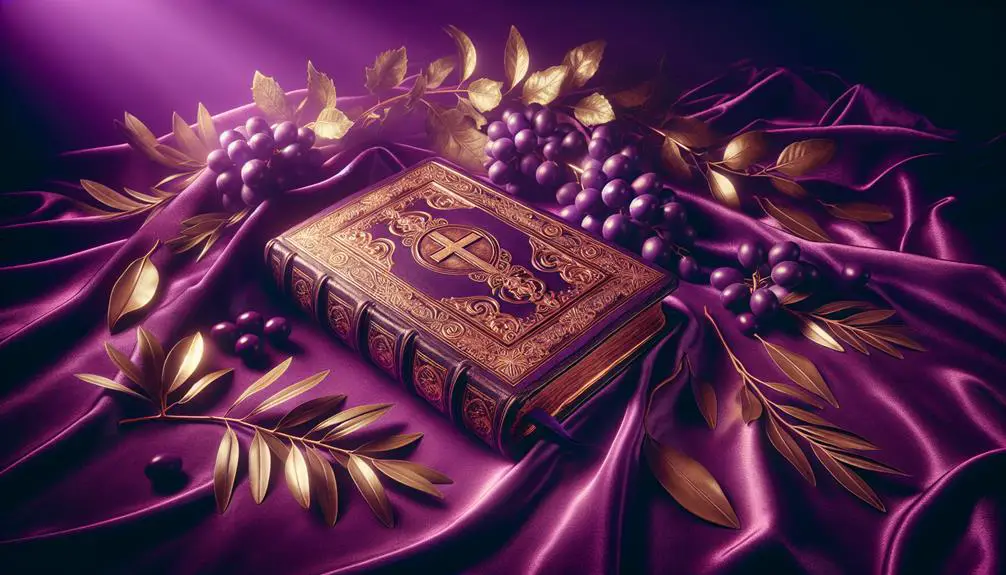
What Does the Color Purple Represent in the Bible
In the Bible, purple cloaks royalty, signifies wealth, and adorns sanctuaries; it's a color that's both deeply symbolic and profoundly historical.
As you explore its significance, you'll uncover how purple threads its way through religious garments, royal imagery, and pivotal scriptural moments.
Beyond its vibrant hue, purple carries meanings that have influenced interpretations and teachings within Christian contexts.
But what deeper symbolism does purple hold, and how has it shaped the understanding of biblical narratives?
Let's embark on this journey together to uncover the layers of meaning behind this regal color in the biblical text.
Key Takeaways
- Purple symbolizes material wealth, royal status, and divine favor in biblical narratives.
- It represents a covenant between the divine and humanity, signifying wisdom, justice, and mercy.
- Purple in scripture reflects the complexity of divine-human relationships and spiritual responsibility.
- Used in religious and royal imagery, purple communicates divine authority and the virtues of governance.
Historical Significance of Purple
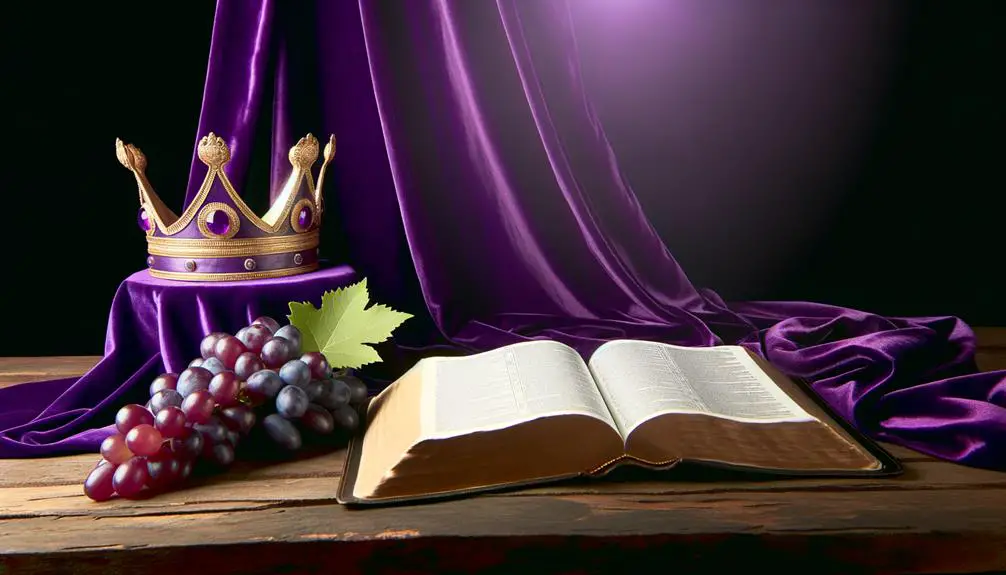
In ancient times, the color purple held profound significance, symbolizing wealth, power, and royalty due to its rarity and the expense involved in its production. The production of purple dye was a labor-intensive process, derived from the murex sea snail, found in select locations in the Mediterranean. Thousands of these snails were required to produce just a gram of dye, making the color accessible only to the affluent and influential. You'd find that the complexity of dye production significantly contributed to its value. The murex dye, known for its vibrant hue and resistance to fading, became a status symbol, coveted across ancient civilizations.
The trade of purple dye and textiles became a pivotal aspect of ancient economies, establishing extensive trade routes that connected distant empires. These routes not only facilitated the exchange of goods but also acted as conduits for cultural and technological exchanges. The Phoenicians, recognized as master seafarers and traders, played a crucial role in the distribution of purple dye throughout the Mediterranean. Their expertise in dye production and trade networks cemented their influence in the ancient world, showcasing how a single color could impact economic and political landscapes.
Analyzing the historical context of purple's significance offers insight into the complexities of ancient societies. The production and trade of purple dye weren't mere economic activities but were intertwined with the social hierarchy and cultural identity of ancient civilizations. This historical backdrop sets the stage to understand the profound symbolism of purple in religious texts, where its use wasn't arbitrary but deeply rooted in centuries-old traditions of power, nobility, and divine favor.
Symbolism in Religious Garments
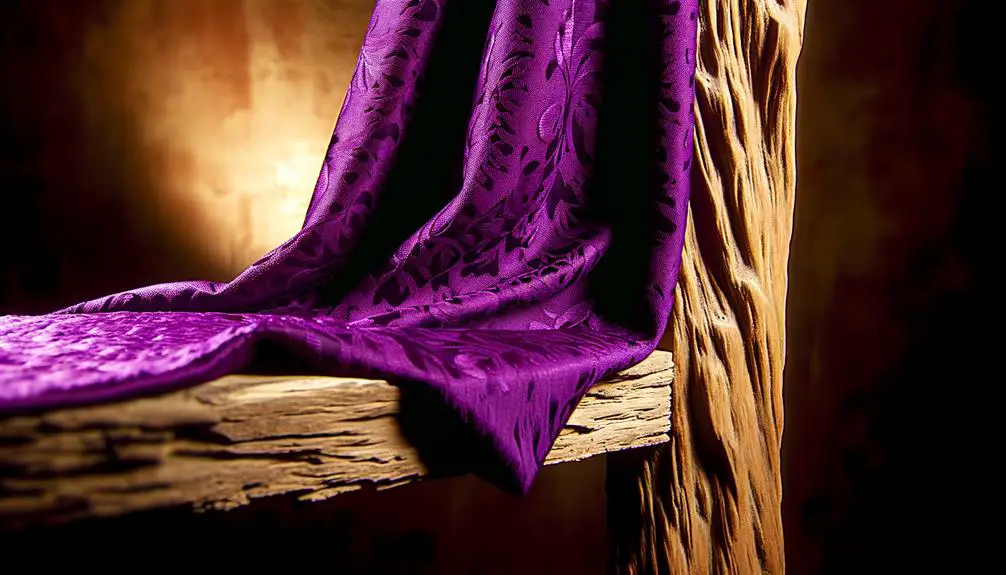
Understanding the historical significance of purple sets the stage for exploring its symbolic representation in religious garments, where it underscores themes of sovereignty, spirituality, and sanctity. In biblical times, the rarity and cost of producing purple dye made it a symbol of wealth and power, attributes that were seamlessly woven into the fabric of clerical attire. This adoption wasn't merely a matter of aesthetics; it was deeply imbued with theological significance, serving as a visual cue of the divine authority and spiritual depth embodied by religious leaders.
The origins of the fabric used for these garments further accentuate their symbolic weight. Derived from the painstaking labor of extracting dye from the Murex shellfish, purple fabric was a luxury few could afford, marking those who wore it as individuals of significant stature within their communities. In the context of religious attire, this exclusivity mirrored the sacred separation of the clergy from laypersons, a distinction that was both spiritual and societal.
Clerical attire adorned in purple thus became a vehicle for communicating the sanctity and authority of religious figures, enveloping them in a visual narrative of spiritual leadership. It's a tradition that, despite the evolution of fabric origins and dyeing techniques, continues to resonate within many religious denominations. The use of purple in these garments isn't just a nod to historical practices but a continued affirmation of the solemn and sacred duties of those who wear them.
In this light, purple's presence in religious garments transcends its physical attributes, becoming a symbol of the spiritual commitment and divine authority vested in religious leadership.
Purple's Role in Royal Imagery
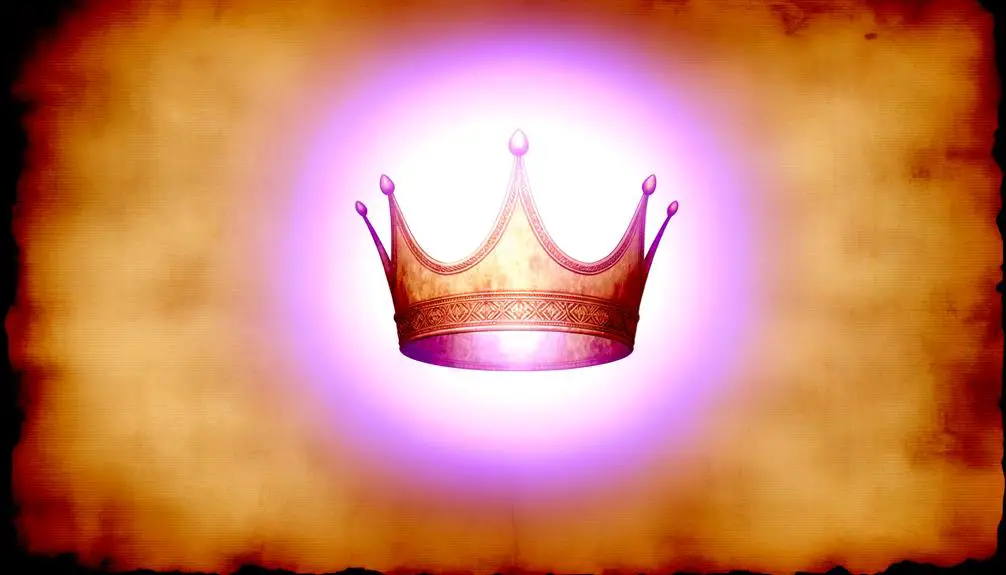
Historically, the color purple has played a pivotal role in royal imagery, symbolizing not only wealth and power but also wisdom and dignity. This association isn't accidental but deeply rooted in color psychology and cultural perceptions that span across civilizations.
You'll find that the rarity and costliness of purple dye, primarily obtained from the labor-intensive process involving sea snails in ancient times, made it exclusive to the elites and monarchs. This exclusivity cemented its status as a symbol of high social standing and authority.
Analyzing this through a scholarly lens, the use of purple in royal regalia across different cultures wasn't just a display of wealth but also a strategic tool for asserting authority and divine right to rule. This color's visual impact and its psychological effects on observers reinforced the ruler's elevated status. It's fascinating to observe how cultural perceptions of color psychology have remained consistent in attributing purple with qualities befitting leadership and nobility.
Moreover, the choice of purple in royal imagery doesn't merely reflect societal hierarchy but also embodies the virtues and responsibilities of governance. The color's association with wisdom and dignity speaks to the ideal qualities of a ruler, emphasizing the role of enlightened leadership. This dual function of purple as a symbol of both material wealth and noble qualities underscores its complex role in cultural expressions of power and leadership.
Instances of Purple in Scripture
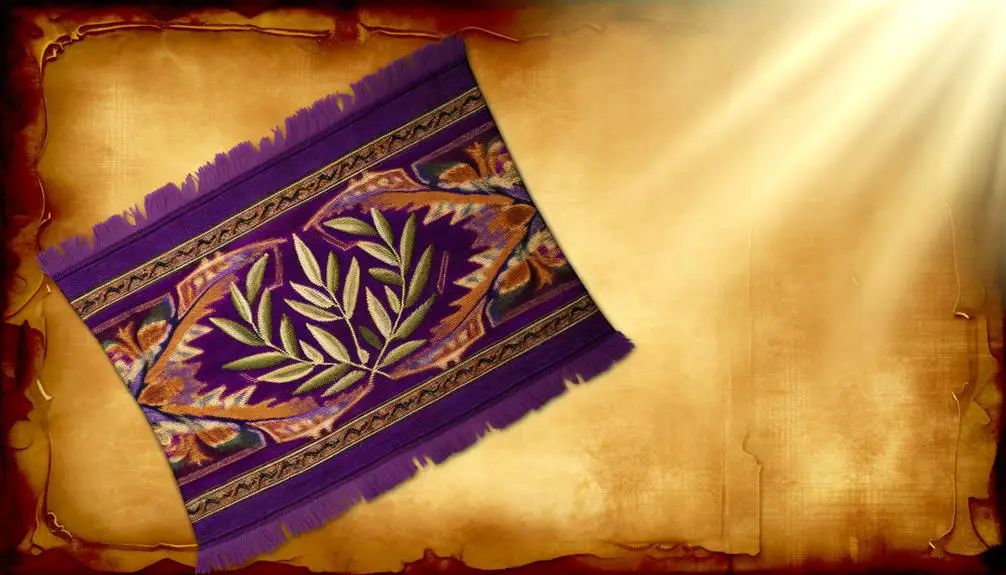
Turning our focus to the sacred texts, we find that purple's significance extends into biblical narratives, where it frequently symbolizes wealth, authority, and divinity. This connection isn't arbitrary but deeply embedded in the cultural and religious practices of the times, as evidenced by several instances where purple plays a pivotal role:
- Purple Offerings: In the construction of the Tabernacle, a portable earthly dwelling place of God amongst the Israelites, purple dyed materials were among the offerings commanded by God (Exodus 25:4). This inclusion signifies purple's esteem and value, marking it as worthy for sacred use.
- High Priest Garments: The attire of the High Priest, detailed in Exodus 28, includes purple among its fabric, symbolizing the priest's royal and divine role in mediating between God and the people. This choice of color underscores the sanctity and authority imbued in the priestly garments.
- Lydia's Conversion: In the New Testament, Lydia, described as a seller of purple goods in Thyatira, undergoes conversion after hearing Paul's preaching (Acts 16:14). Lydia's association with purple goods highlights her prosperity and social standing, yet her conversion signifies a deeper, spiritual wealth.
- Royalty and Divinity: References to purple in parables and descriptions of regal attire (Luke 16:19, Mark 15:17) further cement its association with royalty and, by extension, the divine. These instances underscore the dual nature of purple as a symbol of earthly power and heavenly glory.
Analyzing these examples, it's evident that purple's presence in scripture is multilayered, representing not only material wealth and royal status but also spiritual significance and divine favor.
Interpretations of Purple's Meaning
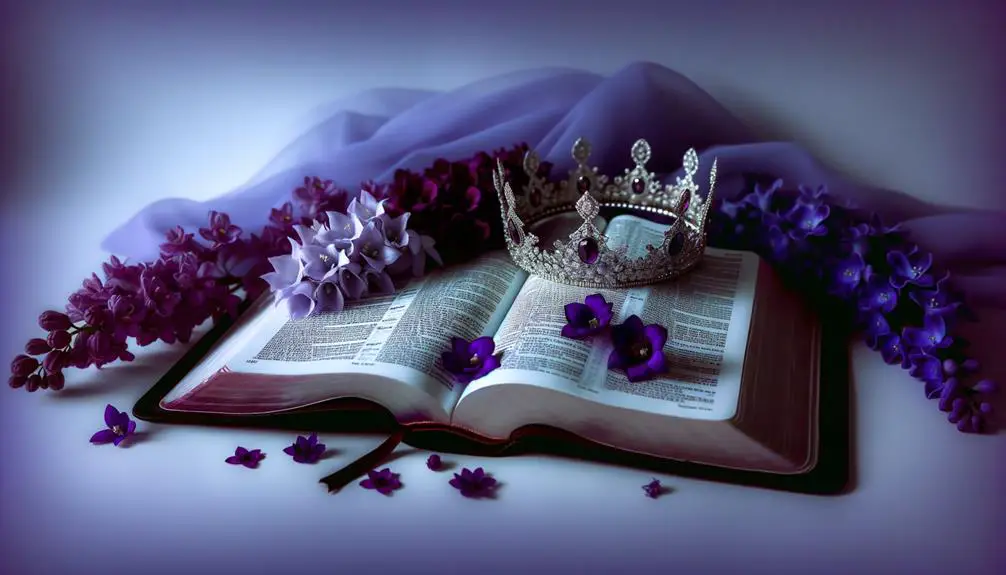
Delving into the symbolism of purple within biblical texts, it's essential to recognize how this color's multifaceted interpretations reflect both material and spiritual dimensions of divinity and authority. Purple's duality is a keystone in understanding its biblical significance, bridging the gap between earthly sovereignty and celestial wisdom. Through color psychology, we grasp that purple often symbolizes wealth, power, and nobility, attributes traditionally associated with kings and rulers. However, in a biblical context, these qualities acquire a deeper, more spiritual layer, highlighting a connection to divine presence and favor.
The interpretations of purple extend beyond mere signs of wealth or regal status. It's a representation of a covenant, a promise between the divine and the mortal. This covenant isn't just about authority or governance but encompasses wisdom, justice, and mercy—qualities that define true leadership under God's guidance. Purple, therefore, becomes a symbol not only of earthly power but of spiritual responsibility and enlightenment.
Moreover, purple's significance in the Bible can't be fully appreciated without acknowledging its role in sacrificial ceremonies. The color, present in fabrics used in the temple, signifies the deep, sacrificial love and the sovereignty of God, bridging the human with the divine. This aspect of purple's meaning emphasizes its role in redemption and salvation narratives, underscoring the color's deep spiritual resonance.
In this light, purple's duality in biblical texts offers a rich tapestry of meanings that reflects the complexity of divine-human relationships. Through the lens of color psychology, we see how purple embodies the multifaceted expressions of divinity, authority, and covenant, making it a powerful symbol in scriptural narratives.
Frequently Asked Questions
How Does the Color Purple Relate to Modern Christian Practices and Celebrations?
In modern Christian practices, you'll see purple vestments and worship decorations, especially during Lent and Advent. This color symbolizes royalty, penitence, and preparation, blending historical biblical significance with contemporary celebration.
Clergy don these purple garments as a nod to tradition, underscoring the solemnity and anticipation of these seasons. Similarly, purple adornments in churches help congregants visually connect with these periods of reflection and await the coming of Christ.
Are There Any Specific Biblical Characters Associated Uniquely With the Color Purple, and What Do Their Stories Tell Us About Its Significance?
Imagine stepping back into a world where colors whisper secrets and power.
In biblical narratives, purple isn't just a hue; it's a proclamation of royalty and symbolic wealth.
Take Lydia, a dealer in purple cloth, reflecting her high status.
Or consider the rich man in Luke, draped in purple, embodying opulence.
Their stories aren't just about fabric; they're narratives woven with the threads of divine symbolism and earthly authority.
How Has the Perception of Purple Changed in Different Christian Denominations Over Time?
In your exploration of purple's evolution within Christianity, you'll find its significance has shifted considerably. Initially tied to purple economics and the costliness of purple dye, it symbolized wealth and status.
Over time, denominational uniforms began to adopt purple, reflecting varied theological interpretations. Each Christian denomination now ascribes its own meaning to purple, illustrating a fascinating divergence rooted in historical, cultural, and doctrinal contexts.
This adaptation reveals much about broader religious dynamics.
In Biblical Translations, How Consistently Is the Color Purple Represented Across Different Languages and Versions?
In exploring biblical translations, it's fascinating to note that over 90% of versions maintain the representation of purple consistently, despite linguistic variations. This high rate underscores the precision in translation methodologies applied across languages.
Such consistency reflects a deep respect for the original texts, ensuring that the symbolic significance of purple transcends cultural and linguistic barriers. This scholarly approach highlights the analytical rigor in preserving the Bible's contextual integrity throughout various translations.
Outside of the Biblical Context, How Has the Symbolism of Purple Influenced Contemporary Religious Art and Architecture?
In contemporary religious art and architecture, you'll find that purple's psychology profoundly influences artistic trends. This color, often associated with spirituality and wisdom, has transcended biblical symbolism to embody a broader spiritual essence.
Its use in modern religious spaces and artworks reflects a deep, contemplative connection to the divine, showcasing how historical symbolism can weave into the fabric of current artistic expression, enriching the spiritual experience beyond traditional contexts.
Conclusion
In the tapestry of biblical narrative, purple weaves a story of sovereignty, sanctity, and sacrifice. Like a royal robe enveloping the shoulders of kings, this color marks those anointed by divine purpose.
Your journey through scripture reveals purple as more than a hue—it's a symbol of the intersection between earthly power and heavenly grace. As you've seen, its presence in holy garments and royal imagery isn't mere coincidence but a deliberate choice, highlighting the sacred amidst the profane, guiding us toward a deeper understanding of divine mysteries.

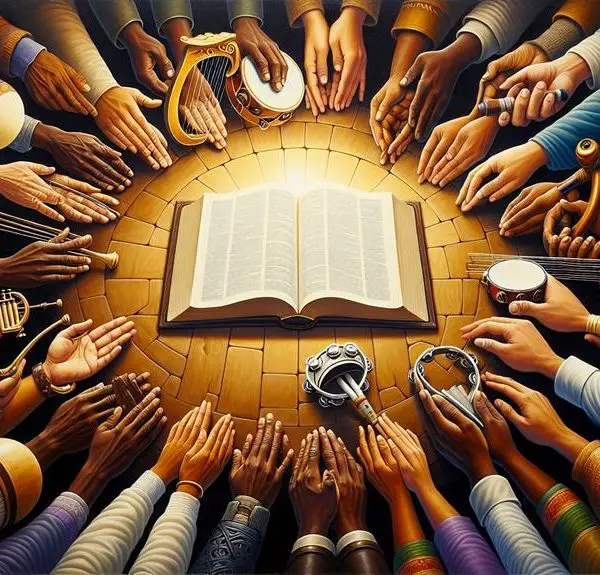

Sign up